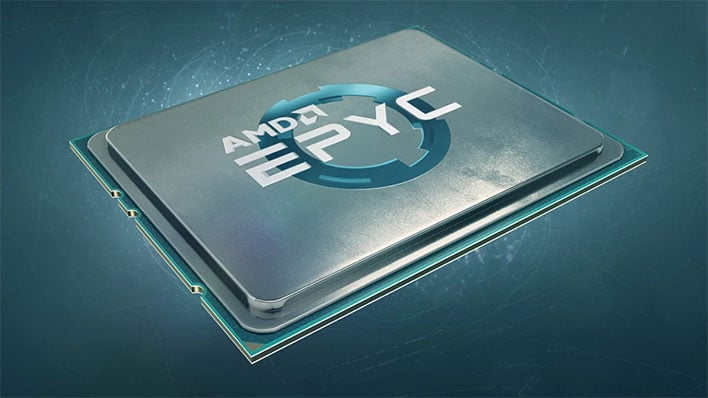Alleged AMD EPYC 32-Core 64-Thread Zen 2 Rome CPU Edges Out Intel Xeon In Latest Leak

AMD is aiming to launch a new round of EPYC server processors in the third quarter of this year, with the new parts based on its latest Zen 2 CPU architecture built on a 7-nanometer manufacturing process. While we wait for the new EPYC "Rome" parts to arrive, AMD has been teasing benchmark demonstrations here and there. How do the new chips really perform, though?
We will not have the answer to the question until they start shipping and get benchmarked outside of AMD's own labs. As that day draws closer, some leaked benchmark figures have found their way to the web, that potentially give us a preview of the new EPYC Rome family. We can also see how performance compares to Intel's Xeon Gold family.
AMD's upcoming EPYC 7452 processor made a brief appearance at OpenBenchmarking. The results have since been pulled, though not before they could be screen-grabbed and preserved for curious eyeballs. Let's start with the specs...
AMD's EPYC 7452 is based on Zen 2 and boasts 32 physical cores and 64 threads. It clocks at 2.35GHz, giving it a 350MHz speed bump over its predecessor, the EPYC 7551 ("Naples"), which has the same number of cores and threads.
In this case, the chip was tested in a dual-socket motherboard, so there are actually two CPUs working in tandem to crunch through workloads. That is a total of 64 cores and 128 threads. Though it is reported that way, it is not to be confused with an actual 64-core/128-thread EPYC processor, which AMD also has on tap.
The EPYC 7452 was tested and compared with not just he Naples part, but also Intel's Xeon Gold 6148 CPU, which has 20 cores and 40 threads clocked at 2.4GHz to 3.7GHz. Like AMD's part, the Xeon processor was tested in a dual-socket configuration.
What about cost and TPD? The Xeon Gold 6148 has a 150W TPD and costs around $3,070. AMD's EPYC 7551 is a 180W part that costs around $3,600. So we expect that the EPYC 7452 will have a lower TDP compared to EPYC 7551, and possibly a lower price tag too (though none of those details have been confirmed).
Now, onto the benchmarks...
There are a variety of workloads depicted above. AMD's EPYC 7452 came out ahead in four of the seven, and scored close to the Intel Xeon part in two of them, including build-php and compress-gzip. Where the EPYC 7452 notched victories, it did so in convincing fashion, for the most part.
Here is a more detailed breakdown of the numbers and performance...

Source: OpenBenchmarks via WCCFTech
Assuming the benchmarks are legitimate, this is a good showing for Rome, and the EPYC 7452 specifically. While none of this is super exciting for the average consumer, it speaks to AMD's shift to 7nm and its Zen 2 architecture, and also the company's ongoing strategy to capture more of the lucrative server market.
As it pertains to that last point, AMD has been chipping away at Intel's dominance in the server sector, with regards to market share. It's been a slow climb, but according to recent data published by Spiceworks, a professional network for the information technology (IT) industry, 5 percent of businesses are expected to add AMD server hardware with in the next two years, and 8 percent if looking at two years and beyond.
Intel will still hold a massive lead in overall server CPU market share, but AMD's Rome lineup could be a big step in the right direction.



